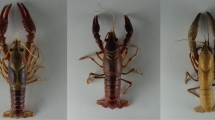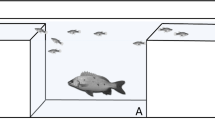Abstract
Behavioural interactions between alien invasive fishes and native fishes is considered one of the drivers of native fish decline. However, there are few experimental studies on their behavioural interactions at the individual level. In this study, we investigated the behavioural interactions between the threatened native killifish Valencia letourneuxi, and the alien invasive Eastern mosquitofish Gambusia holbrooki, thought to induce the killifish’s rapid population decline. The aim was to assess aggressive behaviours, disruption in activity, stress levels, boldness, forging efficiency and shelter use by the native fish in the presence of the mosquitofish. Interspecies interactions were assessed in a three-tiered experimental setup, i.e. in an empty arena, in the presence of an artificial cover, and during feeding, using two opponents at each trial. The behaviours recorded and assessed were nips, following, approach, moving/immobile, top/bottom, erratic movement, cover use, feeding and latency to exit. The results showed that the mosquitofish was bolder, followed the native species, spent significantly less time under the cover and consumed food, as opposed to no following by the native species, significantly higher cover use and time immobile, as avoidance behaviours, and zero feeding in the presence of the mosquitofish. More significantly, the native species received direct aggression by the mosquitofish, as opposed to no aggression at all exhibited by it. Future research needs, as well as the conservation implications of our findings are briefly discussed.






Similar content being viewed by others
Data availability
The datasets are available upon reasonable request.
References
Alcaraz C, Bisazza A, García-Berthou E (2008) Salinity mediates the competitive interactions between invasive mosquitofish and an endangered fish. Oecologia 155(1):205–213. https://doi.org/10.1007/s00442-007-0899-4
Archundia M, Arce E (2019) Fighting behaviour in native fish: the Mexican mojarra (Cichlasoma istlanum) wins when confronted with the non-native convict cichlid fish (Amatitlania nigrofasciata). J Ethol 37(1):67–73. https://doi.org/10.1007/s10164-018-0569-5
Beatty S J, Lear KO, Allen MG, Lymbery AJ, Tweedley JR, Morgan D L (2022) What factors influence fin‐nipping damage by the invasive Gambusia holbrooki (Poeciliidae) on native fishes in riverine systems?. Freshw Biol 67(2): 325–337
Bergstrom MA, Mensinger AF (2009) Interspecific resource competition between the invasive round goby and three native species: logperch, slimy sculpin, and spoonhead sculpin. Trans Am Fish Soc 138(5):1009–1017. https://doi.org/10.1577/T08-095
Bisazza A, Marin G (1991) Male size and female mate choice in the eastern mosquitofish (Gambusia holbrooki: Poeciliidae). Copeia. https://doi.org/10.2307/1446400
Blanchet S, Loot G, Grenouillet G, Brosse S (2007) Competitive interactions between native and exotic salmonids: a combined field and laboratory demonstration. Ecol Freshw Fish 16(2):133–143. https://doi.org/10.1111/j.1600-0633.2006.00205.x
Botham MS, Kerfoot CJ, Louca V, Krause J (2006) The effects of different predator species on antipredator behavior in the Trinidadian guppy, Poecilia. Naturwissenschaften 93:431–439. https://doi.org/10.1007/s00114-006-0131-0
Brodin T, Fogarty S, Sih A, Cote J (2019) Personality-dependent survival of the invasive mosquitofish: being social can be deadly. Aquat Invasions 14(3):465–477. https://doi.org/10.3391/ai.2019.14.3.06
Caiola N, De Sostoa A (2005) Possible reasons for the decline of two native toothcarps in the Iberian Peninsula: evidence of competition with the introduced Eastern mosquitofish. J Appl Ichthyol 21(4):358–363. https://doi.org/10.1111/j.1439-0426.2005.00684.x
Carmona-Catot G, Magellan K, García-Berthou E (2013) Temperature-specific competition between invasive mosquitofish and an endangered cyprinodontid fish. PLoS ONE 8(1):e54734. https://doi.org/10.1371/journal.pone.0054734
Champneys T, Genner MJ, Ioannou CC (2021) Invasive Nile tilapia dominates a threatened indigenous tilapia in competition over shelter. Hydrobiologia 848(16):3747–3762. https://doi.org/10.1007/s10750-020-04341-8
Chifamba PC, Mauru T (2017) Comparative aggression and dominance of Oreochromis niloticus (Linnaeus, 1758) and Oreochromis mortimeri (Trewavas, 1966) from paired contest in aquaria. Hydrobiologia 788(1):193–203. https://doi.org/10.1007/s10750-016-2997-y
Fausch KD (1988) Tests of competition between native and introduced salmonids in streams: what have we learned? Can J Fish Aquat Sci 45(12):2238–2246. https://doi.org/10.1139/f88-26
Franco M, Arce E, Mercado-Silva N, Córdoba-Aguilar A, Ramírez-Rodríguez R (2023) Invasive cichlids (Teleostei: Cichliformes) in the Amacuzac River, Mexico: Implications for the behavioral ecology of the native Mexican mojarra Amphilophus istlanus. Water Biol Secur 100182
Groen M, Sopinka NM, Marentette JR, Reddon AR, Brownscombe JW, Fox MG, Marsh-Rollo SE, Balshine S (2012) Is there a role for aggression in round goby invasion fronts? Behaviour 149(7):685–703. https://doi.org/10.1163/1568539X-00002998
Hermoso V, Clavero M, Blanco-Garrido F, Prenda J (2011) Invasive species and habitat degradation in Iberian streams: an analysis of their role in freshwater fish diversity loss. Ecol Appl 21(1):175–188. https://doi.org/10.1890/09-2011
Jermaczc GH, Coppde GH (2016) Interspecific competition for a shelter between non-native racer goby and native European bullhead under experimental conditions–effects of season, fish size and light conditions. Limnologica 56:30–38. https://doi.org/10.1016/j.limno.2015.11.004
Kalogianni E, Giakoumi S, Andriopoulou A, Chatzinikolaou Y (2010) Feeding ecology of the critically endangered Valencia letourneuxi (Valenciidae). Aquat Ecol 44(1):289–299. https://doi.org/10.1007/s10452-009-9253-8
Kalogianni E, Giakoumi S, Andriopoulou A, Chatzinikolaou Y (2014) Prey utilisation and trophic overlap between the non native mosquitofish and a native fish in two Mediterranean rivers. Mediterranean Mar Sci 15(2):287–301
Kalogianni E, Koutsikos N, Vardakas L, Giakoumi S, Chatzinikolaou Y, Oikonomou A (2019) Impacts of the alien mosquitofish on the abundance and condition of two Mediterranean native fish. Mediterr Mar Sci 20(4):727–735
Kalogianni E, Kapakos Y, Oikonomou A, Giakoumi S, Zimmerman B (2022) Dramatic decline of two freshwater killifishes, main anthropogenic drivers and appropriate conservation actions. J Nat Conserv 67:126191. https://doi.org/10.1016/j.jnc.2022.12619
Keller K, Brown C (2008) Behavioural interactions between the introduced plague minnow Gambusia holbrooki and the vulnerable native Australian ornate rainbowfish Rhadinocentrus ornatus, under experimental conditions. J Fish Biol 73(7):1714–1729. https://doi.org/10.1111/j.1095-8649.2008.02045.x
Leunda PM (2010) Impacts of non-native fishes on Iberian freshwater ichthyofauna: current knowledge and gaps. Aquat Invasions 5(3):239–262. https://doi.org/10.3391/ai.2010.5.3.03
Light T, Marchetti MP (2006) Distinguishing between invasions and habitat changes as drivers of biodiversity loss among California’s freshwater fishes. Conserv Biol 21:434–446. https://doi.org/10.1111/j.1523-1739.2006.00643.x
Lopez LK, Davis AR, Wong MY (2018) Behavioral interactions under multiple stressors: temperature and salinity mediate aggression between an invasive and a native. Biol Invasions 20(2):487–499. https://doi.org/10.1007/s10530-017-1552-8
Lopez LK (2017) The context-dependency of predator-prey and competitive interactions between the invasive eastern mosquitofish, Gambusia holbrooki, and native Australian freshwater fauna, Doctor of Philosophy thesis, School of Biological Sciences, University of Wollongong. https://ro.uow.edu.au/theses1/106. Accessed 30 June 2022
Lorenz OT, O’Connell MT, Schofield PJ (2011) Aggressive interactions between the invasive Rio Grande cichlid (Herichthys cyanoguttatus) and native bluegill (Lepomis macrochirus), with notes on redspotted sunfish (Lepomis miniatus). J Ethol 29:39–46
Lorenz OT, Riccobono SA, Smith P (2016) Effects of salinity on the survival and aggression of the invasive Rio Grande cichlid (Herichthys cyanoguttatus). Mar Freshw Behav Physiol 49(1):1–8
Maceda-Veiga A (2013) Towards the conservation of freshwater fish: Iberian Rivers as an example of threats and management practices. Rev Fish Biol Fish 23(1):1–22. https://doi.org/10.1007/s11160-012-9275-5
Magellan K, García-Berthou E (2016) Experimental evidence for the use of artificial refugia to mitigate the impacts of invasive Gambusia holbrooki on an endangered fish. Biol Invasions 18(3):873–882. https://doi.org/10.1007/s10530-016-1057-x
Magellan K, Alexander M, Deacon A, Wong M (2019) Behaviour and aquatic invasions in the 21st century: progress, trends and future research. Aquat Invasions 14(3):412–416. https://doi.org/10.3391/ai.2019.14.3.01
Mills MD, Rader RB, Belk MC (2004) Complex interactions between native and invasive fish: the simultaneous effects of multiple negative interactions. Oecologia 141(4):713–772. https://doi.org/10.1007/s00442-004-1695-z
Noguchi K, Gel YR, Brunner E, Konietschke F (2012) nparLD: an R software package for the nonparametric analysis of longitudinal data in factorial experiments. J Stat Softw. https://doi.org/10.18637/jss.v050.i12
Olivares-Rubio HF, Arce E, Burciaga LM, Franco M, Osorio-Beristain M (2024) Lead has different impacts on behavior of the native Mexican mojarra and invasive convict cichlid. Hydrobiologia, 851(1):147–159
Pyke GH (2005) A review of the biology of Gambusia affinis and G. holbrooki. Rev Fish Biol Fish 15(4):339–365. https://doi.org/10.1007/s11160-006-6394-x
Pyke GH (2008) Plague minnow or mosquito fish? A review of the biology and impacts of introduced Gambusia species. Ann Rev Ecol Evol Syst 39:171–191
Raymond WW, Albins MA, Pusack TJ (2015) Competitive interactions for shelter between invasive Pacific red lionfish and native Nassau grouper. Environ Biol Fishes 98(1):57–65. https://doi.org/10.1007/s10641-014-0236-9
Reid AJ, Carlson AK, Creed IF, Eliason EJ, Gell PA, Johnson PT, Cooke SJ (2019) Emerging threats and persistent conservation challenges for freshwater biodiversity. Biol Rev 94(3):849–873
Ribeiro F, Leunda PM (2012) Non-native fish impacts on Mediterranean freshwater ecosystems: current knowledge and research needs. Fish Manage Ecol 19:142–156. https://doi.org/10.1111/j.1365-2400.2011.00842.x
Rincón PA, Correas AM, Morcillo F, Risueño P, Lobón-Cerviá J (2002) Interaction between the introduced eastern mosquitofish and two autochthonous Spanish toothcarps. J J Fish Biol 61(6):1560–1585. https://doi.org/10.1111/j.1095-8649.2002.tb02498.x
Rowe DK, Smith JP, Baker C (2007) Agonistic interactions between Gambusia affinis and Galaxias maculatus: implications for whitebait fisheries in New Zealand rivers. J Appl Ichthyol 23(6):668–674. https://doi.org/10.1111/j.1439-0426.2007.00912.x
Rowe DK, Moore A, Giorgetti A, Maclean C, Grace P, Wadhwa S, Cooke J (2008) Review of the impacts of gambusia, redfin perch, tench, roach, yellowfin goby and streaked goby in Australia
Sih A, Bell AM, Johnson JC, Ziemba RE (2004) Behavioral syndromes: an integrative overview. Q Rev Biol 79(3):241–277
Sutton TM, Zeiber RA, Fisher BE (2013) Agonistic behavioral interactions between introduced western mosquitofish and native topminnows. J Freshw Ecol 28(1):1–16. https://doi.org/10.1080/02705060.2012.688492
Thompson KA, Hill JE, Nico G (2012) Eastern mosquitofish resists invasion by nonindigenous poeciliids through agonistic behaviors. Biol Invasions 14(7):1515–1529. https://doi.org/10.1007/s10530-012-0176-2
Winandy L, Denoël M (2015) The aggressive personality of an introduced fish affects foraging behavior in a polymorphic newt. Behav Ecol 26(6):1528–1536. https://doi.org/10.1093/beheco/arv101
Acknowledgements
We wish to thank P. Kouraklis for his assistance in fish collection and transportation to HCMR and B. Zimmerman for English language help and for proof reading the ms. This work forms part of the PhD thesis of Y. Kapakos at the Department of Applied Hydrobiology, Agricultural University of Athens (AUA), Greece.
Funding
This study was conducted within the project DECAGON, funded by the A.G. Leventis Foundation, through the London Zoological Society.
Author information
Authors and Affiliations
Contributions
Yiannis Kapakos: conceptualization, methodology, software, formal analysis, investigation, writing, visualization. Ioannis Leris: conceptualization, methodology, software, formal analysis, writing, visualization. Brian Zimmerman: Nafsika Karakatsouli: supervision, writing. Eleni Kalogianni: conceptualization, methodology, resources, writing, supervision, project administration, funding acquisition.
Corresponding author
Ethics declarations
Conflict of interest
The authors declare they have no conflict of interest.
Ethical approval
All experimental procedures were conducted according to the Greek law and conform to ASAB ethical guidelines. HCMR had secured all necessary permits for fish collection from the Greek Ministry of Environment, Energy and Climate Change (permit 9ZE24653Π-ΖΟ6, HCMR Research Ethics Committee under development during the implementation of this work and thus no specific licence to conduct the experiment was required). We conducted pilot tests before the main experiment to fine-tune the setup and procedure. During these tests, the observed level of aggression between the two species was not severe. In the main experiment, we used a long acclimation period (60 min) prior to each trial, and placed gravel on the bottom of the test tank, to reduce stress for both subjects. The experimenter was operating behind an opaque cover, and observed the trials remotely through a camera, to minimize disturbance. After each trial, used fish were placed in a separate compartment in their home tank for monitoring of their health and recovery. We did not observe any bleeding or scale loss during or after the trials, only minor fin damage was visible in some cases. Should there have been cases of severe aggression, the subjects would have been immediately separated using a stick (which was used to separate and guide them into their respective compartment at the end of each stage), and then returned to the used compartment of their housing tank for monitoring. After the conclusion of the experiments, no mortalities or other adverse effects were observed on the subjects, which were maintained in HCMR facilities for breeding purposes and future experimental use.
Additional information
Publisher's Note
Springer Nature remains neutral with regard to jurisdictional claims in published maps and institutional affiliations.
About this article
Cite this article
Kapakos, Y., Leris, I., Karakatsouli, N. et al. Behavioural interactions between a threatened native killifish and the alien invasive Eastern mosquitofish. J Ethol 42, 97–106 (2024). https://doi.org/10.1007/s10164-024-00807-7
Received:
Accepted:
Published:
Issue Date:
DOI: https://doi.org/10.1007/s10164-024-00807-7




